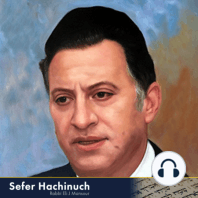20 min listen
Misva #405: Sounding the Shofar on Rosh Hashanah
FromSefer Hachinuch
ratings:
Length:
20 minutes
Released:
Feb 27, 2023
Format:
Podcast episode
Description
The Torah in Parashat Pinhas (Bamidbar 29:1) commands that the occasion of Rosh Hashanah must be observed as a “Yom Teru’a,” a day when the Shofar is sounded. This verse introduces the Biblical command to sound the Shofar each year on Rosh Hashanah. The Torah does not specify the instrument with which the “Teru’a” (“blast”) is to be sounded, but the Sages understood that it refers specifically to a Shofar. This conclusion is reached on the basis of a verse in Parashat Behar (Vayikra 25:9) requiring the sounding of a “Teru’a” with a Shofar on Yom Kippur at the beginning of the Yobel (jubilee year). The Sages inferred from that command that on Rosh Hashanah, too, specifically a Shofar should be used to sound a “Teru’a.” The Sefer Ha’hinuch explains that the Torah commanded sounding a Shofar on Rosh Hashanah in order to motivate us to repent and pray on this day of judgment. Just as a Shofar sounded during wartime to motivate and energize the soldiers, similarly, on Rosh Hashanah, we blow the Shofar to awaken us and alert us to the urgent need to perform Teshuba and improve ourselves as we are now being judged for the coming year. Moreover, the Sefer Ha’hinuch adds, the “Teru’a” is a “broken” sound, a rapid succession of very brief blasts, symbolizing the need to “break” our bad habits and negative impulses, so that we avoid sin. The Shofar must be long enough that it can be seen protruding from either side of one’s hand when he holds it. The Sefer Ha’hinuch writes that the word “Shofar” refers to a hollow animal horn, whereas “Keren” refers to a horn which is not hollow. Any hollow horn is suitable for the Misva, but horns which are not hollow are called a “Keren” and thus deemed unfit for the Misva. An exception is the horn of a cow or bull, which is hollow, but is nevertheless disqualified because it is referred to as a “Keren.” Any sound produced by the Shofar suffices to fulfill the Misva. Thus, if one removes the outer layers of the Shofar, it may be used to fulfill the Misva, even though this has the effect of altering the sound. According to Torah law, the Shofar is sounded on Rosh Hashanah even when it falls on Shabbat. However, the Sages enacted that the Shofar should not be blown on Shabbat, due to the concern that one might carry the Shofar through the public domain, and thus desecrate Shabbat. The Sages made an exception to this rule, allowing sounding the Shofar in the presence of a Bet Din. According to the Rambam, this refers only to a Bet Din of “Semuchin” – judges who received the formal ordination that dates back to Moshe Rabbenu, which has since been lost. By contrast, the Rif (Rav Yishak Alfasi, Algeria, 1013-1103) maintained that the Shofar is blown on Shabbat in any Bet Din whose members are recognized as the leading Rabbis of the generation. It is reported that the Rif himself had the Shofar blown on Shabbat in his yeshiva, where he had a Bet Din. However, even his own students did not follow this practice, and today, clearly, nobody blows the Shofar when Rosh Hashanah falls on Shabbat. The word “Teru’a” appears in the text three times, implying that the Misva requires sounding the Teru’a three times. As the Teru’a must be preceded and followed by a Teki’a sound, it turns out that the Biblical obligation of Shofar requires blowing nine sounds – three sets of the series Teki’a-Teru’a-Teki’a. In ancient times, this indeed was the practice, and everyone would choose which Teru’a sound to blow. The Teru’a sound is to resemble the sound of weeping, but there are different kinds of weeping. Some would blow a Teru’a as a series of rapid, brief blasts (what we today call “Teru’a”), whereas other blew three longer sounds (what we today call “Shebarim”). Others thought that crying is a combination of these two, and so they would blow both series of sounds (what we today call “Shebarim-Teru’a”). In the times of the Gemara, Rabbi Abahu instituted that all three practices should be observed. We therefore blow three ser
Released:
Feb 27, 2023
Format:
Podcast episode
Titles in the series (100)
Misva #8: Leaving Over Meat of the Korban Pesach: Daily Sefer Hachinuch - Brought to you by itorah.com by Sefer Hachinuch
